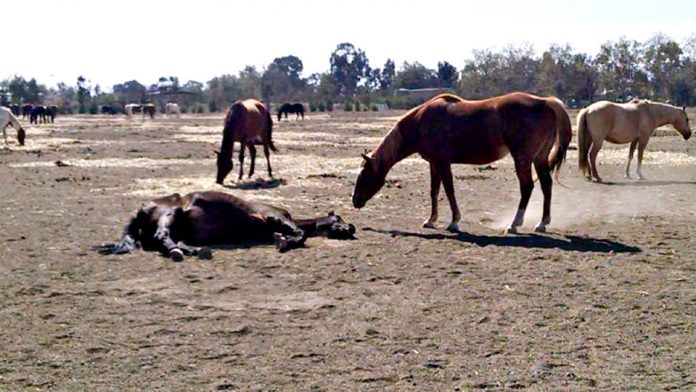
When word of the Morgan Hill/Gilroy neglected horse herd launched on Facebook in response to the mistreatment of more than three dozen horses on two South County ranches (in the summer of 2014), we knew that they needed the help of the equine community, so we stepped in.
Since Santa Clara County Animal Care and Control was doing nothing to assist in the seizure, rescue, and placement of these horses, we worked side by side with the Center Horse advocates and San Martin Animal Shelter to ensure each horse found a safe rescue, sanctuary, foster or forever home. The whole thing was a huge debacle because of ACC’s negligence in addressing this case. Horses were taken off of the property, new horses appeared on the property, and most horses did not end up in rescues in Santa Clara County.
We decided that with the help of a few friends, we could take on one of the pregnant mares. That’s when Cinder came into our lives.
Cinder and several other horses from this herd used to belong to a local breeder in the performance horse industry. Most of these horses were registered Quarter Horses with outstanding pedigree and careers in the cutting industry. Cinder had a successful career as a cutting horse, but eventually this sport wore her down. They turned her into a broodmare for years, producing foal after foal, year after year.
Eventually, they discarded her and that’s how she wound up with the South County herd.
Cinder’s story began the day she was born to a 23-year-old mare, who died after her birth. Like so many of the horses from this herd, Cin came to us pregnant, her conception date unknown due to the fact that this herd was living with numerous stallions and mares together on a small lot on Center Avenue in Gilroy.
Cin got the best care she could get in the months following her departure from Center Avenue. Her board was $315 per month for her to stay at Lakeview Stables in San Jose. The first thing we did was have a vet out to assess her. She was not only pregnant, but had a significant limp that was found to be caused by Navicular, a debilitating syndrome in horses, and fused hocks—most likely the result of the physical demands of being a cutting horse. The extra weight of her foal made her very uncomfortable so we purchased special boots for her to ease some of the pain. Cin adjusted to her new life at Lakeview. The owners agreed to let us build her a stall and a paddock on the hill where she and her new foal would live safely.
All along, we knew Cinder was at risk.
Our daily routine included taking her for walks, letting her graze, and feeding and grooming her. She loved to roll in sand arena, but even this was becoming too difficult for her. I still cherish the times I spent braiding her hair as she grazed on the hillside. She loved her life at Lakeview, and we loved her.
On April 1, just before midnight, Cinder finally delivered a very large, very healthy filly. The delivery was quick and all seemed well. We were relieved, but this relief did not last long. Within hours CinCin started showing signs of distress. We rushed her to Steinbeck where she received several transfusions due to a ruptured uterine artery. She was bleeding internally. She fought all day to stay alive, getting up time and time again, calling to her foal. But they couldn’t save her. I can still see the pain and longing in her eyes…she’d fought so hard to deliver her foal despite the neglect and abuse she’d suffered. We decided to name the foal Belle because after all, she was Cinder’s belly.
Belle required round the clock care with feedings every two hours. We managed to recruit our Lakeview family to help with the feedings and care of Belle that will go on for several months. We were able to find an older mare at the ranch to look after her in her stall and teach her how to be a horse. But Belle is still an orphan…no person or horse can replace her mom.
Belle is a very healthy young filly who reminds us of her beautiful mother. She will grow up in our care and she will never go hungry. But raising an orphan foal is never easy; she will require a lot of extra time and effort. Her formula alone is averaging over $500 per month.
This is the story of just one of the horses from the South County herd. We have spent countless hours rehabilitating and caring for this mare and her foal because we have a broken system that refused to recognize the need for tougher laws and enforcement.
We cannot continue to expect the horse community to pick up the pieces. It has to be controlled at a state and county level.
We MUST change the way we manage our horses in this county. We need to have our own county rescue and partnership so that we can take in horses in need sooner. It is time to reform Santa Clara County ACC.
Loera will give a presentation on the aftermath of the 2014 South County abused horses case at the May 14 Santa Clara County Animal Advisory Committee meeting, which takes place 6:30 p.m. at the County Government Center, 70 W. Hedding Street, San Jose. Rivas, the owner of the nearly 40 malnourished horses, was convicted of felony animal abuse in January.







